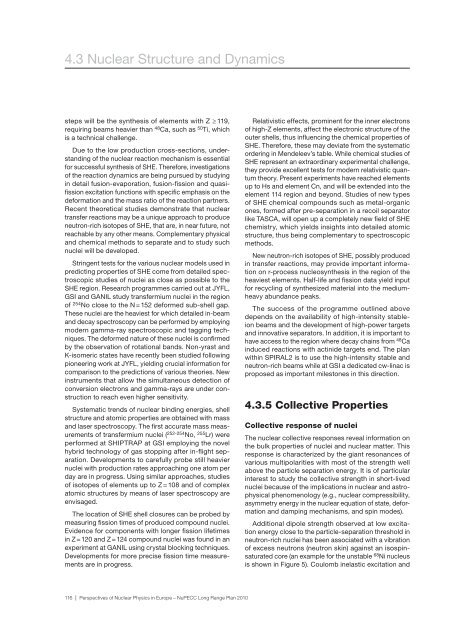Perspectives of Nuclear Physics in Europe - European Science ...
Perspectives of Nuclear Physics in Europe - European Science ...
Perspectives of Nuclear Physics in Europe - European Science ...
Create successful ePaper yourself
Turn your PDF publications into a flip-book with our unique Google optimized e-Paper software.
4.3 <strong>Nuclear</strong> Structure and Dynamics<br />
steps will be the synthesis <strong>of</strong> elements with Z ≥ 119,<br />
requir<strong>in</strong>g beams heavier than 48 Ca, such as 50 Ti, which<br />
is a technical challenge.<br />
Due to the low production cross-sections, understand<strong>in</strong>g<br />
<strong>of</strong> the nuclear reaction mechanism is essential<br />
for successful synthesis <strong>of</strong> SHE. Therefore, <strong>in</strong>vestigations<br />
<strong>of</strong> the reaction dynamics are be<strong>in</strong>g pursued by study<strong>in</strong>g<br />
<strong>in</strong> detail fusion-evaporation, fusion-fission and quasifission<br />
excitation functions with specific emphasis on the<br />
deformation and the mass ratio <strong>of</strong> the reaction partners.<br />
Recent theoretical studies demonstrate that nuclear<br />
transfer reactions may be a unique approach to produce<br />
neutron-rich isotopes <strong>of</strong> SHE, that are, <strong>in</strong> near future, not<br />
reachable by any other means. Complementary physical<br />
and chemical methods to separate and to study such<br />
nuclei will be developed.<br />
Str<strong>in</strong>gent tests for the various nuclear models used <strong>in</strong><br />
predict<strong>in</strong>g properties <strong>of</strong> SHE come from detailed spectroscopic<br />
studies <strong>of</strong> nuclei as close as possible to the<br />
SHE region. Research programmes carried out at JYFL,<br />
GSI and GANIL study transfermium nuclei <strong>in</strong> the region<br />
<strong>of</strong> 254 No close to the N = 152 deformed sub-shell gap.<br />
These nuclei are the heaviest for which detailed <strong>in</strong>-beam<br />
and decay spectroscopy can be performed by employ<strong>in</strong>g<br />
modern gamma-ray spectroscopic and tagg<strong>in</strong>g techniques.<br />
The deformed nature <strong>of</strong> these nuclei is confirmed<br />
by the observation <strong>of</strong> rotational bands. Non-yrast and<br />
K-isomeric states have recently been studied follow<strong>in</strong>g<br />
pioneer<strong>in</strong>g work at JYFL, yield<strong>in</strong>g crucial <strong>in</strong>formation for<br />
comparison to the predictions <strong>of</strong> various theories. New<br />
<strong>in</strong>struments that allow the simultaneous detection <strong>of</strong><br />
conversion electrons and gamma-rays are under construction<br />
to reach even higher sensitivity.<br />
Systematic trends <strong>of</strong> nuclear b<strong>in</strong>d<strong>in</strong>g energies, shell<br />
structure and atomic properties are obta<strong>in</strong>ed with mass<br />
and laser spectroscopy. The first accurate mass measurements<br />
<strong>of</strong> transfermium nuclei ( 252-254 No, 255 Lr) were<br />
performed at SHIPTRAP at GSI employ<strong>in</strong>g the novel<br />
hybrid technology <strong>of</strong> gas stopp<strong>in</strong>g after <strong>in</strong>-flight separation.<br />
Developments to carefully probe still heavier<br />
nuclei with production rates approach<strong>in</strong>g one atom per<br />
day are <strong>in</strong> progress. Us<strong>in</strong>g similar approaches, studies<br />
<strong>of</strong> isotopes <strong>of</strong> elements up to Z = 108 and <strong>of</strong> complex<br />
atomic structures by means <strong>of</strong> laser spectroscopy are<br />
envisaged.<br />
The location <strong>of</strong> SHE shell closures can be probed by<br />
measur<strong>in</strong>g fission times <strong>of</strong> produced compound nuclei.<br />
Evidence for components with longer fission lifetimes<br />
<strong>in</strong> Z = 120 and Z = 124 compound nuclei was found <strong>in</strong> an<br />
experiment at GANIL us<strong>in</strong>g crystal block<strong>in</strong>g techniques.<br />
Developments for more precise fission time measurements<br />
are <strong>in</strong> progress.<br />
Relativistic effects, prom<strong>in</strong>ent for the <strong>in</strong>ner electrons<br />
<strong>of</strong> high-Z elements, affect the electronic structure <strong>of</strong> the<br />
outer shells, thus <strong>in</strong>fluenc<strong>in</strong>g the chemical properties <strong>of</strong><br />
SHE. Therefore, these may deviate from the systematic<br />
order<strong>in</strong>g <strong>in</strong> Mendeleev’s table. While chemical studies <strong>of</strong><br />
SHE represent an extraord<strong>in</strong>ary experimental challenge,<br />
they provide excellent tests for modern relativistic quantum<br />
theory. Present experiments have reached elements<br />
up to Hs and element Cn, and will be extended <strong>in</strong>to the<br />
element 114 region and beyond. Studies <strong>of</strong> new types<br />
<strong>of</strong> SHE chemical compounds such as metal-organic<br />
ones, formed after pre-separation <strong>in</strong> a recoil separator<br />
like TASCA, will open up a completely new field <strong>of</strong> SHE<br />
chemistry, which yields <strong>in</strong>sights <strong>in</strong>to detailed atomic<br />
structure, thus be<strong>in</strong>g complementary to spectroscopic<br />
methods.<br />
New neutron-rich isotopes <strong>of</strong> SHE, possibly produced<br />
<strong>in</strong> transfer reactions, may provide important <strong>in</strong>formation<br />
on r-process nucleosynthesis <strong>in</strong> the region <strong>of</strong> the<br />
heaviest elements. Half-life and fission data yield <strong>in</strong>put<br />
for recycl<strong>in</strong>g <strong>of</strong> synthesized material <strong>in</strong>to the mediumheavy<br />
abundance peaks.<br />
The success <strong>of</strong> the programme outl<strong>in</strong>ed above<br />
depends on the availability <strong>of</strong> high-<strong>in</strong>tensity stableion<br />
beams and the development <strong>of</strong> high-power targets<br />
and <strong>in</strong>novative separators. In addition, it is important to<br />
have access to the region where decay cha<strong>in</strong>s from 48 Ca<br />
<strong>in</strong>duced reactions with act<strong>in</strong>ide targets end. The plan<br />
with<strong>in</strong> SPIRAL2 is to use the high-<strong>in</strong>tensity stable and<br />
neutron-rich beams while at GSI a dedicated cw-l<strong>in</strong>ac is<br />
proposed as important milestones <strong>in</strong> this direction.<br />
4.3.5 Collective Properties<br />
Collective response <strong>of</strong> nuclei<br />
The nuclear collective responses reveal <strong>in</strong>formation on<br />
the bulk properties <strong>of</strong> nuclei and nuclear matter. This<br />
response is characterized by the giant resonances <strong>of</strong><br />
various multipolarities with most <strong>of</strong> the strength well<br />
above the particle separation energy. It is <strong>of</strong> particular<br />
<strong>in</strong>terest to study the collective strength <strong>in</strong> short-lived<br />
nuclei because <strong>of</strong> the implications <strong>in</strong> nuclear and astrophysical<br />
phenomenology (e.g., nuclear compressibility,<br />
asymmetry energy <strong>in</strong> the nuclear equation <strong>of</strong> state, deformation<br />
and damp<strong>in</strong>g mechanisms, and sp<strong>in</strong> modes).<br />
Additional dipole strength observed at low excitation<br />
energy close to the particle-separation threshold <strong>in</strong><br />
neutron-rich nuclei has been associated with a vibration<br />
<strong>of</strong> excess neutrons (neutron sk<strong>in</strong>) aga<strong>in</strong>st an isosp<strong>in</strong>saturated<br />
core (an example for the unstable 68 Ni nucleus<br />
is shown <strong>in</strong> Figure 5). Coulomb <strong>in</strong>elastic excitation and<br />
116 | <strong>Perspectives</strong> <strong>of</strong> <strong>Nuclear</strong> <strong>Physics</strong> <strong>in</strong> <strong>Europe</strong> – NuPECC Long Range Plan 2010
















